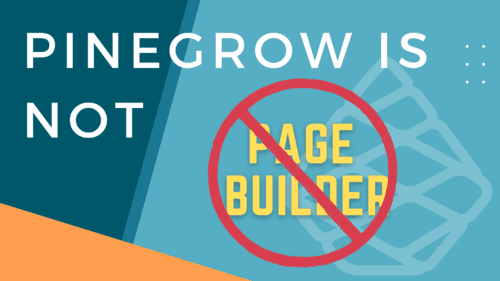Pinegrow is Not a Page Builder
Pinegrow is Not a Page Builder
After yesterday’s announcement of the Pinegrow WordPress plugin, the question I was asked over and over was, “How is this different from every other page builder?”
Put simply, Pinegrow is not a page builder. It’s a fully featured, visual, custom blocks and themes builder. You see, typical WordPress page builders are designed to let you lay out and design the elements on a page. More recently, they have started adding theme-building features so you can define your global styles and page templates.
The problem with Page builders is that you are now locked into their ecosystem. If you or your clients want to make a content change to a page builder page, you have to load the whole builder. Now, instead of teaching your clients how to use WordPress, you now have to teach them how to also use the page builder. You are also at the mercy of the page builder’s product roadmap. It’s not uncommon for releases to have breaking changes, where you are now on the hook to spend hours figuring out what happened and how to fix it. When they add new features or change the interface, you now have to edit all your documentation or re-train your customers. And, in the case of some page builders, they completely undermine the way core WordPress system were designed to work.
Pinegrow, on the other hand, is not meant to design single pages. It’s designed to make custom blocks to use with the WordPress block editor or complete custom themes that control the entire look, feel, and behavior of your site.
Blocks that you create inside Pinegrow are packaged up into a single custom plugin that you activate and use just as if you were hand-coding a block plugin. The same goes for themes. If you open your theme directory, you’ll see a standard WordPress theme that can be installed, activated, or moved like any other.
This means that working in Pinegrow is going to take a bit of a mental shift, and not everything is going to work the way you are used to. It also means that you might need to learn a bit about the way WordPress is designed to work on the back-end since Pinegrow tries to stay as close as possible to WordPress standards.
Recent Posts
About the Recent WordPress Drama
As many of you have heard, there is some drama in the WordPress space right now. If you haven’t heard anything yet, consider yourself lucky to have avoided the needless drama so far. In this post, I’ll cover what is happening, who is impacted, why it’s important, how we are protecting you, and some thoughts […]
Using Sass with Pinegrow
I recently had someone ask whether Pinegrow supports Sass, so I thought I’d do a quick video demonstration. In this demo, I show you how we activate our Sass stylesheet and how we can use a simple Sass variable to change the color of a heading.
Pinegrow Countdown: Day 1 – Pinegrow Plays Nice with Others
A lot of products in the WordPress space have grown in popularity, primarily because of their open and flexible ecosystem that allows 3rd party developers to create add-ons, extensions, and libraries. Pinegrow also has a great plugin API. But I’m going to show you in this video, that in most cases, you don’t even need it.
Pinegrow Countdown: Day 2 – Pinegrow is STILL not a Page Builder
In this video, I’m going to show you why Pinegrow is different from Page Builders so you don’t fall into the trap of trying to use it like something it’s not, only to get frustrated and give up.
Pinegrow Countdown: Day 3 – Frameworks in Pinegrow
Pinegrow has built some fantastic helpers for popular frameworks. In fact, when you start a new project in either Pinegrow Desktop or the Pinegrow WordPress plugin, you’ll be asked which framework you want to choose. If you are already used to using one of the built-in frameworks, the choice will be easy. If not, this little video will hopefully help you understand what the frameworks do and how you should answer those important initial questions.



